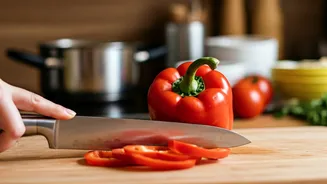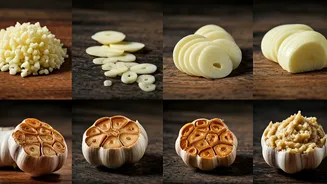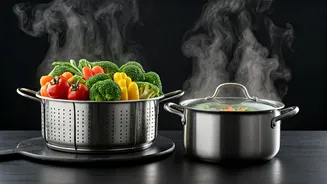Core Cooking Techniques
Mastering the basics is crucial for every aspiring cook. Several fundamental techniques form the bedrock of cooking proficiency, including sautéing, which
involves quickly cooking food in a pan with a small amount of fat over medium-high heat. The objective is to achieve a lightly browned exterior while preserving moisture inside. Braising is another crucial method; it involves browning food, typically meat, and then simmering it in liquid, covered, at a low temperature for an extended period. This process tenderizes tougher cuts of meat while imbuing them with rich flavor. Roasting is also important, involving dry-heat cooking in an oven, ideally at moderate to high temperatures, allowing food to brown on the outside. Similarly, grilling requires cooking over direct heat, best suited for foods that cook quickly and benefit from a smoky char. Finally, boiling and poaching, used to cook in water, with poaching being a more gentle, submerged cook at lower temperatures. Understanding these techniques empowers cooks to handle various ingredients and create different dishes effectively.
Understanding Flavor Profiles
Developing a keen understanding of flavor is key to becoming an outstanding cook. Flavor profiles are essentially the unique combinations of tastes (sweet, sour, salty, bitter, and umami) and aromas that define a dish. Consider the interplay of these elements. Sweetness often balances acidity, while salt enhances all other flavors. Texture also plays an important part, as does aroma, which can greatly affect the perceived flavor. Successful cooks learn to balance these different elements. For example, a dish might use the tang of citrus (sourness) and counter it with a touch of sweetness, along with salt to enhance the overall taste. Experimenting with herbs, spices, and seasonings to build intricate flavor profiles is essential. By continually tasting and adjusting seasonings, a cook can learn to develop a discerning palate and the ability to craft dishes with complex, satisfying flavors.
Essential Kitchen Equipment
Equipping a kitchen with the right tools makes cooking considerably easier and more enjoyable. Beginning with the basics, a good chef's knife is the most versatile and is essential for tasks like chopping vegetables, trimming meat, and more. Cutting boards are important for protecting countertops and offering a stable surface for food preparation. Measuring cups and spoons are crucial for accurate ingredient measurements, ensuring consistent results in your dishes. Similarly, pots and pans form the core of the cooking surface. Non-stick pans are excellent for delicate foods, while stainless steel and cast iron offer versatility, and each provides different cooking properties. Mixing bowls, whisks, and spatulas are indispensable for mixing, whipping, and folding ingredients. Beyond these basics, you might consider other items like a food processor or blender for additional convenience and culinary options. Investing in quality equipment from the start helps you work more efficiently, creatively, and safely in the kitchen.
Food Safety Practices
Food safety should be a top priority for any cook. Safe food handling ensures that the food you prepare is safe for consumption and prevents potential illness. Washing hands thoroughly before and after handling food is vital. Cross-contamination, where bacteria spread from one surface to another, must be avoided. Keep raw meat, poultry, and seafood separate from other foods, and use separate cutting boards and utensils. Cooking food to its proper internal temperature is also essential. Use a food thermometer to check the temperature, ensuring that meats are cooked to safe levels to kill any harmful bacteria. Refrigerating leftovers quickly and properly is another key part of food safety. Aim to get leftovers into the refrigerator within two hours of cooking. Proper food safety practices safeguard against foodborne illnesses, allowing you to prepare and enjoy meals with peace of mind.
Tips for Success
Enhancing your cooking skills involves continuous learning and applying a few key strategies. Start with simple recipes and gradually build your confidence. Always read the entire recipe before you start to familiarize yourself with the process. Mise en place, which means 'everything in its place,' is essential for organized and efficient cooking. It involves prepping and arranging all the ingredients before you begin cooking. Don’t be afraid to experiment, trying out new flavors and techniques. Learn from mistakes by analyzing what went wrong, and then adjust accordingly. Taste and adjust seasonings throughout the cooking process to ensure a balanced flavor. Finally, don’t be scared to seek advice from cooking resources like online videos, cookbooks, and experienced cooks. By implementing these practices and striving for excellence, you'll become a successful and knowledgeable cook.













